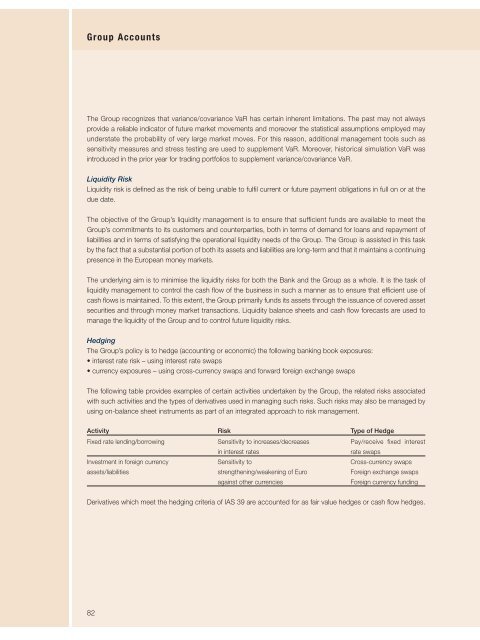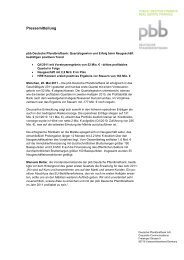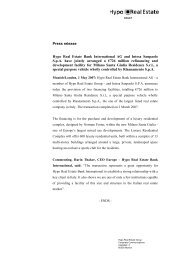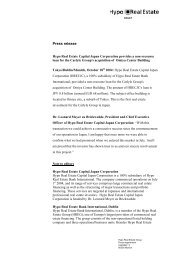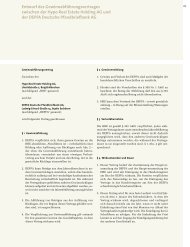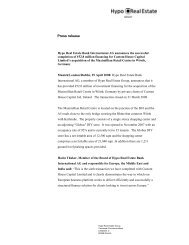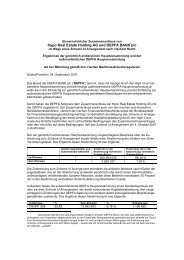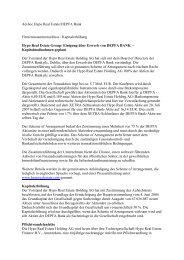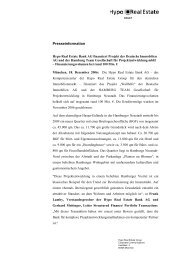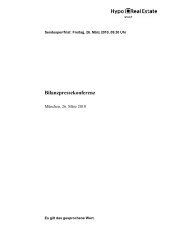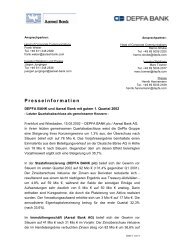annual report - Hypo Real Estate Holding AG
annual report - Hypo Real Estate Holding AG
annual report - Hypo Real Estate Holding AG
Create successful ePaper yourself
Turn your PDF publications into a flip-book with our unique Google optimized e-Paper software.
Group Accounts<br />
The Group recognizes that variance/covariance VaR has certain inherent limitations. The past may not always<br />
provide a reliable indicator of future market movements and moreover the statistical assumptions employed may<br />
understate the probability of very large market moves. For this reason, additional management tools such as<br />
sensitivity measures and stress testing are used to supplement VaR. Moreover, historical simulation VaR was<br />
introduced in the prior year for trading portfolios to supplement variance/covariance VaR.<br />
Liquidity Risk<br />
Liquidity risk is defined as the risk of being unable to fulfil current or future payment obligations in full on or at the<br />
due date.<br />
The objective of the Group’s liquidity management is to ensure that sufficient funds are available to meet the<br />
Group’s commitments to its customers and counterparties, both in terms of demand for loans and repayment of<br />
liabilities and in terms of satisfying the operational liquidity needs of the Group. The Group is assisted in this task<br />
by the fact that a substantial portion of both its assets and liabilities are long-term and that it maintains a continuing<br />
presence in the European money markets.<br />
The underlying aim is to minimise the liquidity risks for both the Bank and the Group as a whole. It is the task of<br />
liquidity management to control the cash flow of the business in such a manner as to ensure that efficient use of<br />
cash flows is maintained. To this extent, the Group primarily funds its assets through the issuance of covered asset<br />
securities and through money market transactions. Liquidity balance sheets and cash flow forecasts are used to<br />
manage the liquidity of the Group and to control future liquidity risks.<br />
Hedging<br />
The Group’s policy is to hedge (accounting or economic) the following banking book exposures:<br />
interest rate risk – using interest rate swaps<br />
currency exposures – using cross-currency swaps and forward foreign exchange swaps<br />
The following table provides examples of certain activities undertaken by the Group, the related risks associated<br />
with such activities and the types of derivatives used in managing such risks. Such risks may also be managed by<br />
using on-balance sheet instruments as part of an integrated approach to risk management.<br />
Activity Risk Type of Hedge<br />
Fixed rate lending/borrowing Sensitivity to increases/decreases Pay/receive fixed interest<br />
in interest rates rate swaps<br />
Investment in foreign currency Sensitivity to Cross-currency swaps<br />
assets/liabilities strengthening/weakening of Euro Foreign exchange swaps<br />
against other currencies Foreign currency funding<br />
Derivatives which meet the hedging criteria of IAS 39 are accounted for as fair value hedges or cash flow hedges.<br />
82


